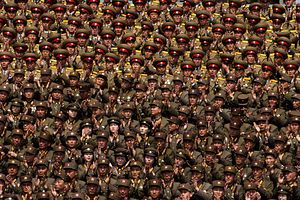North Korea limply flexed its military muscles a week ahead of the first ruling party meeting in over three decades, with two apparently unsuccessful missile launches.
Pyongyang fired what appeared to be two intermediate-range ballistic missiles on Thursday, but both crashed after launch, defense officials in South Korea and the United States said. Though never successfully tested, the Musudan missile is believed to have a potential range of some 3,000 kilometers, bringing Japan and the U.S. territory of Guam within reach, as well as South Korea. The UN Security Council is due to convene over the launches, which contravene international sanctions.
The abortive show of military might came just days ahead of the 7th Congress of the Workers’ Party of Korea, the first such meeting since 1980. Supreme leader Kim Jong-un is widely expected to use the rare forum, scheduled for May 6, to solidify his authority and outline the future direction of the country.
Months of military flexing have foreshadowed the congress. Pyongyang conducted its fourth successful nuclear weapons detonation in January and the following month launched a satellite on a rocket, which much of the international community deemed to be a covert ballistic missile test.
While North Korea is nuclear capable, there is disagreement about its claim of being able to miniaturize a warhead and place it on a missile.
John Delury, an associate professor of East Asian Studies at Seoul’s Yonsei University, said the abortive launches were intended to showcase Kim’s power ahead of his big showing before the ruling party.
“Kim Jong-un is trying hard to prove his capabilities and unfortunately… it’s the military half of byungjin,” he said, referring to Kim’s stated goal of pursuing nuclear weapons and economic development in tandem. “So the question now is how much more he has to do in order… to demonstrate both domestically and internationally his strength. That’s what this is all about.”
The regime is widely expected to carry out a fifth nuclear test in the near future.
As for the other half of byungjin — economic development — progress is less evident. Despite initial hopes that his Swiss education might incline Kim toward economic liberalization, the North Korean leader has so far only introduced limited piecemeal reforms, such as allowing farmers to keep a greater share of their produce for themselves. But Delury said there were still hopes that the party congress would place a major emphasis on the economy.
“I think what you would be looking for is not some dramatic policy announcement, but some signaling — but still some clear signaling — to say we’ve achieved the nuclear half of byungjin, sort of make that past tense.”
With the nuclear ambition achieved, Delury said, Kim could tell his people that the economy was the next big task: “[Kim can say] ‘We did it: We made a H-bomb, we’ve miniaturized, we can deliver it and the world knows, so they’re not going to mess with us. So we’re secure and now we are going to push on becoming prosperous.’”

































